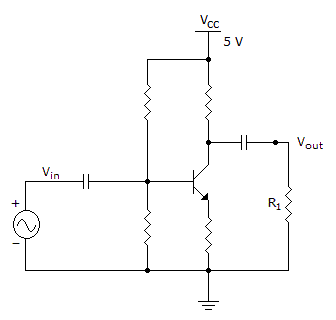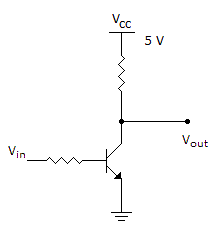Bipolar Junction Transistors (BJT) problems
- 1. With a PNP circuit, the most positive voltage is probably:
Options- A. ground
- B. VC
- C. VBE
- D. VCC Discuss
Correct Answer: ground
- 2. A common-emitter (C-E) is so called because the emitter is connected to both the input and output signals.
Options- A. True
- B. False Discuss
Correct Answer: True
- 3. In this analog amplifier the input is in phase with the output.

Options- A. True
- B. False Discuss
Correct Answer: False
- 4. A decrease in base current of a C-E amplifier causes the voltage measured between the emitter and the collector to increase.
Options- A. True
- B. False Discuss
Correct Answer: True
- 5. A bipolar transistor has three leads: the base, collector, and emitter.
Options- A. True
- B. False Discuss
Correct Answer: True
- 6. Transistors are controlled to operate as a switch or to operate as a variable resistor.
Options- A. True
- B. False Discuss
Correct Answer: True
- 7. In a common-base (C-B) amplifier, the output is 180 degrees out of phase with the input.
Options- A. True
- B. False Discuss
Correct Answer: False
- 8. In a BJT, the collector current is approximately equal to the base current.
Options- A. True
- B. False Discuss
Correct Answer: False
- 9. If this circuit were used in a digital circuit, it would be a NOT gate.

Options- A. True
- B. False Discuss
Correct Answer: True
- 10. With a common-collector (C-C) amplifier the input is applied to the base and the output is taken from the emitter.
Options- A. True
- B. False Discuss
Correct Answer: True
More in Electronics:
Programming
Copyright ©CuriousTab. All rights reserved.
